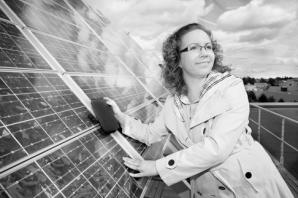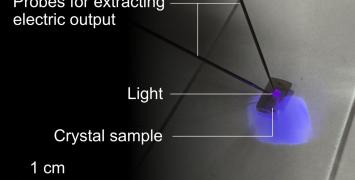A brighter future? Anti-ageing treatment for solar panels
Solar power is potentially an almost limitless resource. The sun provides enough energy in one minute to supply the world’s energy needs for one year. But turning this resource into affordable electricity is difficult – silicon-based solar cells still suffer from a decline in their effectiveness over time. Through her ERC-funded SOLARX project, Professor Hele Savin, of Aalto University in Finland, is investigating a possible route to solving this problem.

“This degradation is observed but not yet fully understood,” she says, explaining that the power output of solar cells is seen to decline as they age. “Currently, up to 20 % efficiency loss is due to this effect, although the reasons are still unknown. Industry is trying to tackle the problem by using better quality, but more expensive materials, or by using different dopants in the silicon, but to date there is no cost-effective solution.”
This is where Prof. Savin’s background in electronic engineering has come in useful: having studied Microelectronics at Helsinki University of Technology (TKK), she is currently Head of the Electron Physics Group in the Micro- and Nano-Sciences Department at the Aalto University School of Electrical Engineering in Finland.
Copper-bottomed reasoning
In recent years, the technologies and materials used in microelectronics and silicon-based photovoltaic (PV) solar cells have been converging. Prof. Savin is now trying to apply her previous research to solve a problem in this new field.
“My proposal is that copper impurities in the silicon, reacting with light, cause the decline in power output,” she says. “There is always copper in the silicon used in large PV cells – either pre-existing impurities or resulting from the production process – and this copper can move around, diffusing through the silicon, even at room temperature.”
“In my PhD I studied copper in microelectronics – in particular, copper contamination in silicon,” she continues. “I used light to make the copper electrically active. I wanted to produce this effect, but my hypothesis is that this also explains the degradation the PV industry would like to prevent. When you expose photovoltaic cells to sunlight, it makes the copper impurities electrically active, they move and accumulate so that existing clumps grow bigger, and this is what damages the PV cell and disrupts the flow of electric current.”
Prof. Savin’s research group is therefore developing a solution using a negative charge at the surface of the silicon – exploiting the insulation properties of the protective oxidised coatings common to most PV cells. The surface therefore attracts copper ions – instead of them accumulating in clusters – and the flow of electric power remains unaffected.
“The degradation effect is slow, so the experiments have to last days,” she says. “The ERC’s support has meant we can focus on solving this issue for the next five years – with a postdoc and PhD student devoted to it – and use the specialised tools available at the Micronova facility for controlling copper-contaminant levels.”
Micronova is Finland’s national research infrastructure for micro- and nanotechnology, run by the VTT Technical Research Centre of Finland and Aalto University. Its dedicated equipment allows Prof. Savin to study the effects of copper in silicon alone, while avoiding cross-contamination from other impurities.
“This project is basic science, but the production capacity and market for PV technology is already huge, so there will be a big technological impact if it works – and applications could potentially arrive quite quickly,” she says. “On the other hand, even if it doesn’t work at an industrial scale, a better understanding of the science of this effect could also be a significant result, leading to other, better solutions in the future.” After hydro and wind power, solar energy based on photovoltaics is already the third most important renewable energy source – with more than 100 GW of capacity installed globally. So, by continuing with her work, Prof. Savin may help to bring an energy revolution – based on reliable, renewable power – one step closer.
“My dream is that technology developed by me will be utilised by the global photovoltaic industry,” she concludes.






